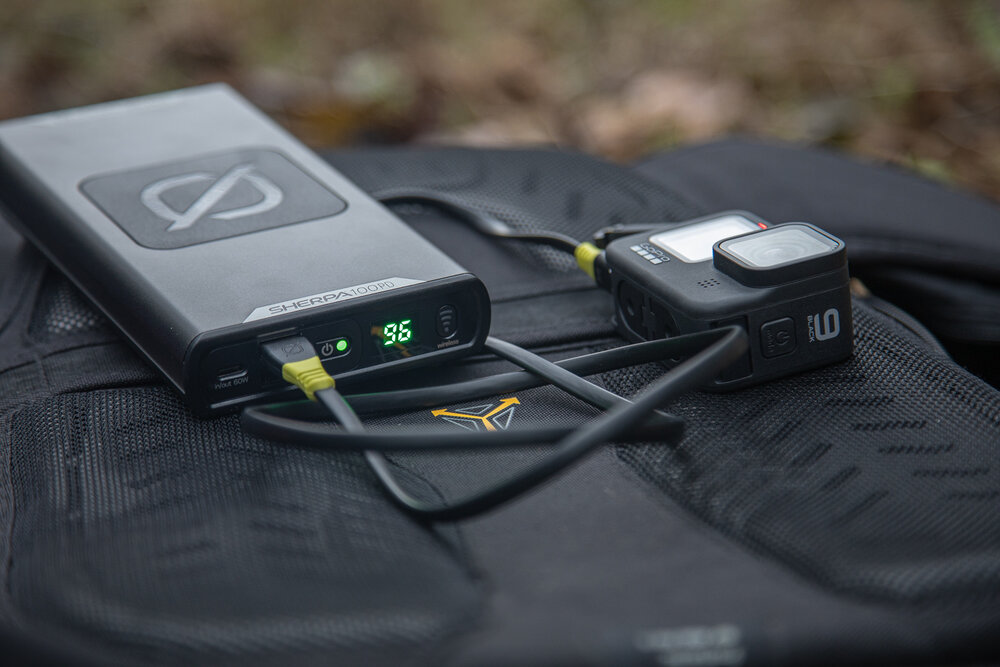Devices are taking over our lives. It’s a double edged sword with so many cool gadgets and gizmos helping us out but at the same time we’re tethered to screens and power. In the comments of any power bank article the haters yell, ‘leave the devices at home!’
I see both sides. Some hikes and paddles my inReach and GPS are probably the only thing that comes with me and they stayed packed away until the rare occasion they’re needed.
Other road trips or car camping trips where I’m trying to get some photography and writing done, I’ll have a GoPro, Canon mirrorless camera, laptop, phone, GPS, and inReach, not to mention all the USB campsite lights.
Whether you like it or not we need power to charge things. Battery packs have become a necessity for outdoors, travelling or even just charging around the house. GoalZero make a couple larger battery packs that are exceptional when it comes to the heavy duty charging we have to do sometimes.
Goal Zero Sherpa 100PD Laptop Power Bank
It’s a long name for a pretty small device. At it’s core the Sherpa 100PD is just a big battery pack. But it’s got some fancy features that make it more powerful than your basic Anker battery.
Let’s get the specs out of the way in case you’re looking for those and then we can dig into what makes it unique.
Specs:
-
94.72 Wh (just under airline limit)
-
Qi charging pad on top
-
60W PD power delivery ports
-
two 2.4A USB type A ports
Now what does these specs mean?

The Sherpa 100PD is smaller and lighter than the 100AC but with fewer ports.
The 100PD can charge 4 devices at one time. 2 with the USB Type-A ports (rectangle ports), 1 with the USB-C (rounded port), and one with the Qi wireless charging pad on top.
The rectangle Type-A ports charge just like older laptops and computer ports would with 2.4A. These are great for slowly charging phones and other devices that don’t support any sort of fast charging.
The rounded USB-C PD port is a 60 watt Power Delivery port meaning this can charge compatible devices much faster. This port can charge your phone or larger devices like mirrorless cameras and even laptops like the USB-C Macbook Pros. When you’re on the road or travelling, that bit of extra juice to get through work on the laptop or just a movie makes all the difference.
The USB-C port is also the input.
How many times will the 100PD charge a phone?
As always charging times depend on your phone, the battery, the temperature, the altitude, and whether it’s a Tuesday with a full moon in the summer.
Goal Zero says the 100PD can charge a tablet 4 times, a phone 8 and laptop twice. If you have a smaller battery on your phone it will be less. My iPhone 7 with it’s 7.5 watt-hour battery can be charged more than 8 times from this.
My Macbook Pro has a 76 watt-hour battery can be charged just over one time.
Charging the 100PD
Goal Zero includes a long USB-A to USB-C cable in the box so you can charge it from a USB plug on the wall or on your computer. Using a regular USB outlet, it takes about 8-10 hours to charge.
If you buy the optional 45 watt fast charger, that reduces to 3 hours.

Improvements
The 100PD is a solid charger that I take with me everywhere now but there are some improvements I’d love to see.
With everything getting faster and faster these days, it’d be nice to get the fast charger in box and not have it separate. On the other hand, once everyone has their own fast chargers then getting yet another one is a bit of a hassle.
With everything going USB-C now, I’d love to have 2 of these ports and just one of the old regular USB ports.
Compared to some of the other batteries without the rugged case, the GoalZero is a bit on the heavy side. I like it because I tend to drop things and want them to last. I usually take a smaller, lighter battery pack backpacking with me when I go which is the only time I’d really be worried about the weight. In the car or at home it doesn’t matter.
Compared to the Sherpa 100AC

Sherpa 100PD battery pack beside the larger Sherpa 100AC.
The 100PD has a very similar sibling, the Sherpa 100AC with the same 94 wH capacity.
The 100AC is a bit larger and has a full AC port on it. Not everything runs on USB. With that comes a fan to cool things down when it heats up. The fan only runs when the AC port is being used.
The 100AC also has 2 60W USB-C PD ports, 2 Type-A ports, Qi wireless charger and an 8mm input for plugging in solar panels.
The small screen on the 100AC gives you more info about how many watts are going in and out.
If you need more ports or the AC port and don’t mind the size increase, then the 100AC is for you. If you’re looking for a little more streamlined and lighter weight then the 100PD is a good one to look at. They both have the same capacity and charge at the same speed.
Check out the full Sherpa 100AC review.
Conclusion
It’s hard to go anywhere these days without carrying extra power. These big battery packs aren’t for the fast and light trips but car camping, road trips, travelling or even extended backpacking the Sherpa 100PD might be the perfect charging station for you.
Both the 100AC and the 100PD have worked flawlessly so far, one just being bigger with more ports than the other. Now I just need to find all my USB cords.
More Photos




